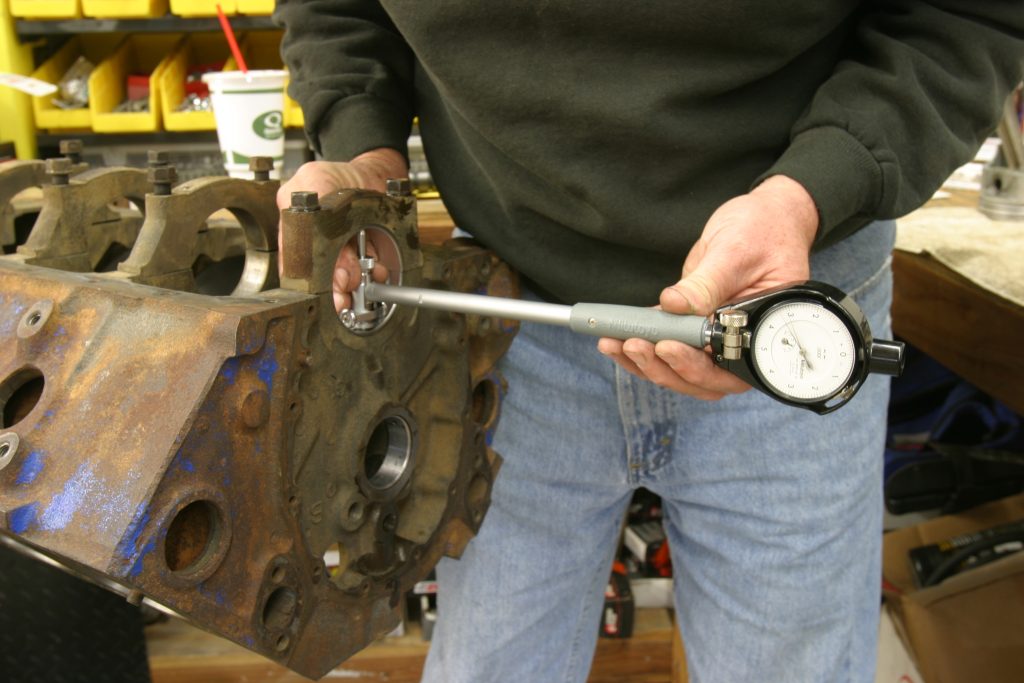I have a 350ci small block that I thought would be easy to rebuild. My brother ran it out of oil in his 1957 Chevy so we pulled the engine and took it apart. The bearings actually didn’t look bad and the crank seemed okay, so we had it polished. It measured about 0.001 inch undersized, so we just bought a set of 0.001 inch bigger (undersized) bearings and we were ready to put it back together. We decided to have a friend come over and measure our crank and use his dial bore gauge to measure our clearances just to be safe. Mains one through four measured around 0.0025 to 0.0028 inch (which is okay) but Number Five measured way big right at 0.005 inch clearance!
Should we have this crank turned 0.010 under or just buy a new crank?
J.D.
It will take a little more information to give you the best answer but we can narrow down the approach slightly, which should help. I applaud you for taking the time to actually measure the crank and the inside diameter of the main bearings as opposed to just slapping this engine back together. The information you learned probably saved you from a larger problem after the engine was installed into the vehicle that would only cost more time and effort to repair.
When measuring bearing clearance, the key is to remember that most discrepancies between your expected bearing clearance and what you really have is often linked to the housing bore. In your case, the Number Five main journal on the crankshaft is probably about 0.001 inch undersize compared to a brand new crankshaft. Add this situation to the issue that the Number Five thrust main bearing housing bore is probably oversized by at least 0.001 inch.
This is a classic example of what engineers call tolerance stack-up.
In your situation, the crank journal is slightly undersize and the housing bore is slightly oversize. Add those together and you could easily come up somewhere around a 0.004 inch bearing clearance or more. The fact that you measured 0.005 inch probably means that each were a little more than 0.001 inch under- and over-sized. Generally the Number Five runs with slightly more clearance to make sure the thrust surfaces receive plenty of lube.
As for the quick fix, a new crankshaft will only tighten Number Five’s clearance by roughly 0.0010 to 0.0015 inch, which won’t be nearly enough to create the proper clearance. We’re basing this estimate on the assumption that both the undersized crank and the oversized housing bore are of equal amounts. The best course would really be to spend a little more money and have the block align-honed.
As part of this solution, the machine shop will mill the main caps roughly 0.0015 inch or so and then use a long bar hone to open the main bearing housing bores back out to the standard mid-point for the main bearing housing bore inside diameter. The price for this work will vary based on geographic area but it will likely be about the same price as a stock replacement cast crank. This machine work will put the housing bores in the correct dimension and will bring the bearing clearance out with standard main bearings to around 0.0025 inch with the Number Five closer to 0.0028 to 0.0030 inch—which would be acceptable.
A new crankshaft will have a much tighter tolerance for each main journal, which will offer a narrower range of clearances between all five main journals. Summit Racing has 3.48 inch stroke small block crankshafts that are very affordable and, in some cases, might be less expensive than having your crank turned. 0.010 inch undersize.
Used crankshaft journals will vary and that will produce a wider range of clearances. A difference of roughly plus or minus 0.0003 inch is not unusual but it might be more. If the variance is more than +/- 0.0005 inch, you might look into having the crankshaft turned undersize 0.010 inch. This is not expensive but again it might cost around the same money as a new crank. Either way, this will make it much easier to establish a common main bearing clearance that will be successful.
The combination of having the crankshaft turned and the block align-honed may come to around $450 to $500, but that investment will pay off with an engine that will last a very long time, making the investment more than worthwhile.


Comments